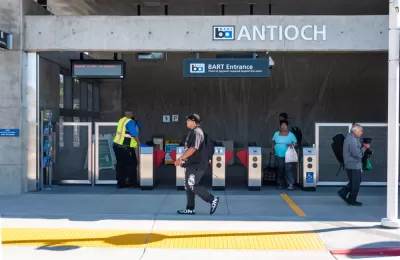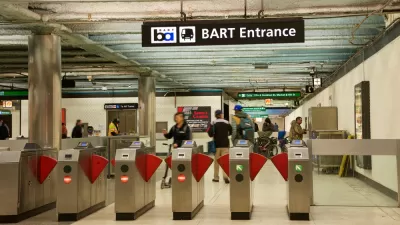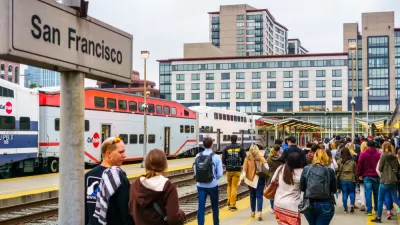Advocates for ‘seamless’ transit are calling on California state leaders to tie a consolidation study to a one-time injection of funding into the Bay Area’s transit systems.

In an op-ed for Streetsblog San Francisco, Ian Griffiths argues for the consolidation of the Bay Area’s multiple transit agencies, which face significant funding shortages and projected service cuts.
Griffiths acknowledges the need for immediate relief: “Legislators must provide significant one-time funding for transit in the upcoming budget to avert service cuts if they are serious about their commitment to transit, equity, and fighting climate change.”
But “If there was ever a time to take a hard look at agency consolidations – combining some of our 27 agencies to both improve decision-making, capacity, effectiveness, and efficiency – it is now.”
Griffiths notes that riders have been calling for a seamless regional system. Advocacy group Seamless Bay Area argues that “Bay Area Transit needs a Regional Network Manager entity with systemwide accountability for public transit – capable of planning and running transit as one network.” Consolidating, for example, BART and Caltrain “would enable speedier implementation of integrated service and fares between the two systems (enabling quicker ridership regrowth), improved capital project planning, faster project delivery, and improved agency capacity.”
Griffiths concludes by pointing out that consolidating the region’s transit requires state action. “As the state considers one-time funding for transit operations in this year’s budget, legislators can help support a seamless transit system by calling for a consolidation study to be completed over the next year that identifies key consolidation options, benefits, and costs for the legislature to consider implementing.”
FULL STORY: Op-ed: Consolidate the Bay Area’s Transit Agencies

Alabama: Trump Terminates Settlements for Black Communities Harmed By Raw Sewage
Trump deemed the landmark civil rights agreement “illegal DEI and environmental justice policy.”

Planetizen Federal Action Tracker
A weekly monitor of how Trump’s orders and actions are impacting planners and planning in America.

The 120 Year Old Tiny Home Villages That Sheltered San Francisco’s Earthquake Refugees
More than a century ago, San Francisco mobilized to house thousands of residents displaced by the 1906 earthquake. Could their strategy offer a model for the present?

Opinion: California’s SB 79 Would Improve Housing Affordability and Transit Access
A proposed bill would legalize transit-oriented development statewide.

Record Temperatures Prompt Push for Environmental Justice Bills
Nevada legislators are proposing laws that would mandate heat mitigation measures to protect residents from the impacts of extreme heat.

Downtown Pittsburgh Set to Gain 1,300 New Housing Units
Pittsburgh’s office buildings, many of which date back to the early 20th century, are prime candidates for conversion to housing.
Urban Design for Planners 1: Software Tools
This six-course series explores essential urban design concepts using open source software and equips planners with the tools they need to participate fully in the urban design process.
Planning for Universal Design
Learn the tools for implementing Universal Design in planning regulations.
Clanton & Associates, Inc.
Jessamine County Fiscal Court
Institute for Housing and Urban Development Studies (IHS)
City of Grandview
Harvard GSD Executive Education
Toledo-Lucas County Plan Commissions
Salt Lake City
NYU Wagner Graduate School of Public Service





























